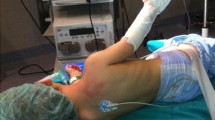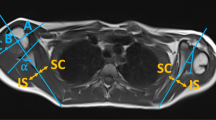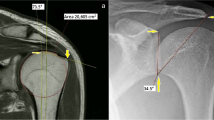Abstract
Purpose: To evaluate rotator cuff muscles and the glenohumeral (GH) joint in brachial plexus birth injury (BPBI) using MRI and to determine whether any correlation exists between muscular abnormality and the development of glenoid dysplasia and GH joint incongruity. Materials and methods: Thirty-nine consecutive BPBI patients with internal rotation contracture or absent active external rotation of the shoulder joint were examined clinically and imaged with MRI. In the physical examination, passive external rotation was measured to evaluate internal rotation contracture. Both shoulders were imaged and the glenoscapular angle, percentage of humeral head anterior to the middle of the glenoid fossa (PHHA) and the greatest thickness of the subscapular, infraspinous and supraspinous muscles were measured. The muscle ratio between the affected side and the normal side was calculated to exclude age variation in the assessment of muscle atrophy. Results: All muscles of the rotator cuff were atrophic, with the subscapular and infraspinous muscles being most severely affected. A correlation was found between the percentage of humeral head anterior to the middle of the glenoid fossa (PHHA) and the extent of subscapular muscle atrophy (rs=0.45, P=0.01), as well as between its ratio (rs=0.5, P P=0.01). Severity of rotator cuff muscle atrophy correlated with increased glenoid retroversion and the degree of internal rotation contracture. Conclusions: Glenoid retroversion and subluxation of the humeral head are common in patients with BPBI. All rotator cuff muscles are atrophic, especially the subscapular muscle. Muscle atrophy due to neurogenic damage apparently results in an imbalance of the shoulder muscles and progressive retroversion and subluxation of the GH joint, which in turn lead to internal rotation contracture and deformation of the joint.







Similar content being viewed by others
References
Miller SF, Glasier CM, Griebel ML, et al (1993) Brachial plexopathy in infants after traumatic delivery: evaluation with MR imaging. Radiology 189:481–484
Evans-Jones G, Kay SPJ, Weindling AM, et al (2003) Congenital brachial palsy: incidence, causes and outcome in the United Kingdom and Republic of Ireland. Arch Dis Child Fetal Neonatal Ed 88:185–189
Sjöberg I, Erichs K, Bjerre I (1988) Cause and effect of obstetric (neonatal) brachial plexus palsy. Acta Paediatr Scand 77:357–364
Gilbert WM, Nesbitt TS, Danielsen B (1999) Associated factors in 1611 cases of brachial plexus injury. Obstet Gynecol 93:536–540
Hui J, Torode I (2003) Changing glenoid version after open reduction of shoulders in children with obstetric brachial plexus palsy. J Pediatr Orthp 23:109–113
Pearl MI, Edgerton BW (1998) Glenoid deformity secondary to brachial plexus birth palsy. J Bone Joint Surg 80:659–667
Pearl MI, Edgerton BW, Kon DS, et al (2003) Comparison of arthroscopic findings with magnetic resonance imaging and arthrography in children with glenohumeral deformities secondary to brachial plexus birth palsy. J Bone Joint Surg 85:890–898
Beischer A, Simmons T, Torode I (1999) Glenoid version in children with obstetric brachial plexus palsy. J Pediatr Orthop 19:359–361
Hernandez RJ, Dias L (1988) CT evaluation of the shoulder in children with Erb’s palsy. Pediatr Radiol 18:333–336
Waters P, Peljovich AE (1999) Shoulder reconstruction in patients with chronic brachial plexus birth palsy. Clin Orthop 364:144–152
van der Sluijs JA, van Ouwerkerk WJ, de Gast A, et al (2001) Deformities of the shoulder in infants younger than 12 months with an obstetric lesion of the brachial plexus. J Bone Joint Surg 83:551–555
Friedman R, Hawthrone K, Genez B (1992) The use of computerized tomography in the measurement of glenoid version. J Bone Joint Surg 74:1032–1037
Waters P, Smith G, Jaramillo D (1998) Glenohumeral deformity secondary to brachial plexus birth palsy. J Bone Joint Surg 80:668–677
Pollock AN, Reed MH (1989) Shoulder deformities from obstetrical brachial plexus paralysis. Skeletal Radiol 18:295–297
Mintzer CM, Waters PM, Brown DJ (1996) Glenoid version in children. J Pediatr Orthop 16:563–566
Kozin SH (2004) Correlation between external rotation of the glenohumeral joint and deformity after brachial plexus birth palsy. J Pediatr Orthop 24:189–193
Fleckenstein JL, Weatherall PT, Bertocci LA, et al (1991) Locomotor system assessment by muscle magnetic resonance imaging. Magn Reson Q 7:79–103
Fleckenstein JL, Watumull D, Conner KE, et al (1993) Denervated human skeletal muscle: MR imaging evaluation. Radiology 187:213–218
Acknowledgements
This study was supported by the Foundation for Pediatric Research, Helsinki, Finland, the Pehr Oscar Klingendahl Foundation, Helsinki, Finland, and the Radiological Society of Finland.
Author information
Authors and Affiliations
Corresponding author
Rights and permissions
About this article
Cite this article
Pöyhiä, T.H., Nietosvaara, Y.A., Remes, V.M. et al. MRI of rotator cuff muscle atrophy in relation to glenohumeral joint incongruence in brachial plexus birth injury. Pediatr Radiol 35, 402–409 (2005). https://doi.org/10.1007/s00247-004-1377-3
Received:
Accepted:
Published:
Issue Date:
DOI: https://doi.org/10.1007/s00247-004-1377-3




